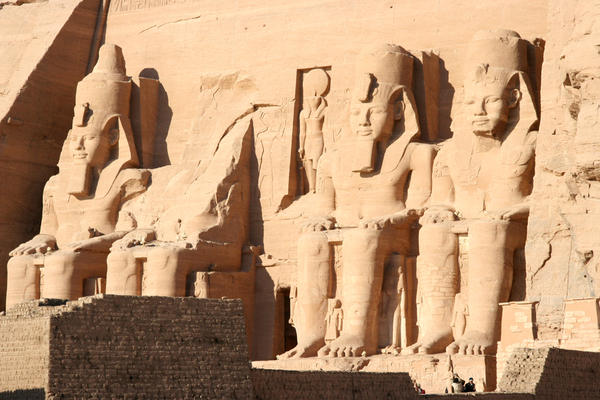When visiting Egypt a must do experience is to visit the temple of Ramses II in the small fishing village of Abu Simbel,it is one of the most historically and culturally impressive heritage sites in the world . The temple which was built in 1250BC is immense in size and visually spectacular and is one of the best preserved in the Nubian area of Egypt. It is carved out of the side of a rock and as you approach four mammoth statues of the Pharaoh tower above you. The statues were thought to have been to scare off enemies approaching from down the River Nile and to show off the wealth and power of the great Pharaoh. The temple is dedicated to Ramses and the sun Gods Ra, Amuh and Ptah, and the temples design itself shows celebration of the sun with statues of baboons who the Egyptians thought of as ‘watchers of the dawn’ lifting their arms to welcome the sun.

- Temple of Ramses II at Abu SimbelMerlin_1 / Foter.com / CC BY-NC-ND
Perhaps the most stunning archaeological aspect of the temple occurs on the 22nd of February and October when the sun shines down the entire length of the temple and illuminates the statues of the Gods, all except Ptar the God of the underworld who remains in darkness. This is a great time of year to visit the temple as locals hold the Abu Simbel Sun Festival to celebrate Ramses birthday which features music, dance and food. Make sure to get to the temple early if you are visiting on the day of the festival in order to see the full visually spectacular event as it gets very crowded. Inside the temple ancient hieroglyphics depict stories of Ramses and the Battle of Kadesh. As well as visiting Ramses temple, the smaller temple he built for his much beloved wife Nefertiti is also worth a visit, as Ramses was one of the only Pharaohs to honour his wife with a temple.
Ramses temple was almost lost to the world in the 1960’s as it was threatened by submersion from Lake Nasser when the High Dam was being built. The Egyptian government and UNESCO undertook a mammoth operation to dismantle the two temples block by block and raise them 60 metres above the cliff. The operation itself is well known as it was a massive excursion. In the temple there is a photograph exhibition detailing how it was carried out. The temple was rebuilt in exactly the same points as the original making sure that when the sun hits on the 22nd of Febuary and October the temple was still illuminated.To get the most out of the visit it is best to go with an Egyptologist who can give all the facts and the incredible history of the temple.
The desert around the temple gets very hot and the recommended time to go to the temple is very early in the morning, there are a few ways to get to the temple, such as buses and planes and river cruises. It takes about 3.5 hours to get to the temple from Aswan on the coach through the dessert. Although many people do not choose to stay in Abu Simel overnight as there is not much else to see there except the temple, in the evening there is a light and sound show which lights up the temple in an exhilarating way and tells the stories of egotistical Ramses and of the building of the temple, it is highly entertaining and well worth a seeing. The temple truly is one of the seven wonders of the world, and with such remarkable history to learn about it is definitely worth travelling such a long way to see.




